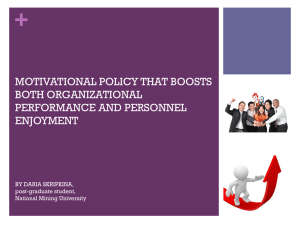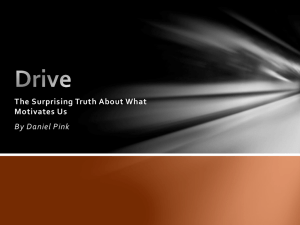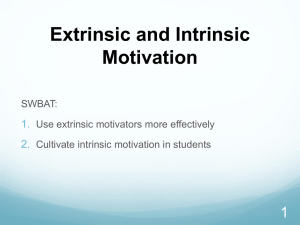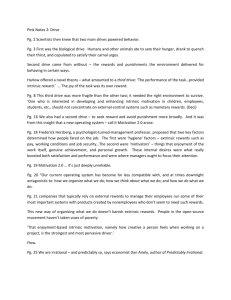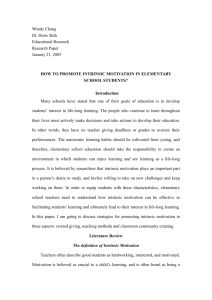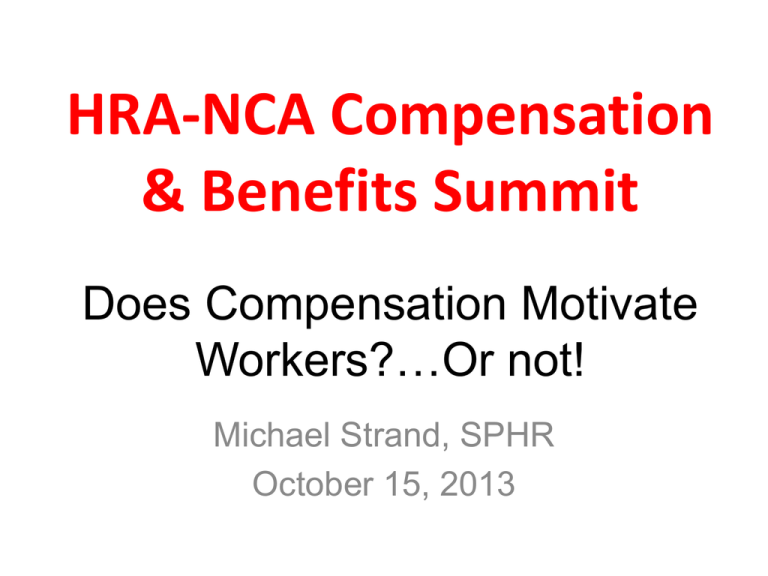
HRA-NCA Compensation
& Benefits Summit
Does Compensation Motivate
Workers?…Or not!
Michael Strand, SPHR
October 15, 2013
What Is Motivation?
• A driving force.
• Causes workers to complete a task.
• A psychological feature that arouses an
organism to act towards a desired goal and
elicits, controls, and sustains certain goal
directed behaviors.
2
Two Books
Drive by Daniel H. Pink
Punished by Rewards by Alfie Kohn
X
3
Two Approaches to Motivation
• Frederick Taylor (1890-1911)
– Scientific Management
– Time & Motion Studies
– Stop Watches
• Henry Fayol (1916)
– Principles of
Management
• B.F. Skinner (1948+)
– Behavioral Management
– Actions Controlled by
Punishment & Reward
4
• According to Taylor: “Work consists mainly of
simple, not particularly interesting, tasks. The
only way to get people to do the tasks is to
incentivize them properly and monitor them
carefully.”
• In the early 1900s, Taylor had a point. Today, in
much of the world, it is less true.
• For some people work remains routine,
unchallenging, and directed by others.
• But for a large number of people, jobs have
become more complex, more interesting, and
more self-directed.
5
Two Different Task Categories
• Algorithmic: You follow
a set of established
instructions…down a
single pathway…to one
conclusion. (There is an
algorithm for solving it.)
• Heuristic: No algorithm
exists for the task.
• You have to experiment
with possibilities and
devise a novel solution.
6
• In the twentieth century, most work was
algorithmic. Blue collar jobs shifted to white
collar jobs. Unions, to survive, shifted their
organizing activities to white collar jobs: teachers
and government workers.
• Routine white collar work is disappearing. Jobs
are going offshore: to India, China, the
Philippines.
• Lower-paid workers in these offshore locations
essentially run the algorithm. They figure out the
correct answer and deliver it instantaneously
from their computer to someone thousands of
miles away.
7
• External rewards and punishments (carrots &
sticks) --- can work nicely for algorithmic
tasks…but they can be devastating for
heuristic ones.
8
Trends in the Workforce
• Telecommuting: less direct supervision…more
worker autonomy…more worker control over
how he/she completes the tasks.
• Organizations Flatten…become leaner and
develop less of a hierarchy. To reduce costs,
they trim managerial layers.
– Result: managers supervise more workers and
therefore scrutinize each one less closely. They
rely more on the workers to do their tasks on their
own. As organizations flatten, companies need
people who are self-motivated.
9
• Routine, not-so-interesting jobs require
direction.
• Non-routine, more interesting work depends
on self-direction.
• A Manager: “It is not my job to motivate my
workers. I expect them to motivate
themselves.”
• A Job Interviewer: “If you need me to
motivate you, I probably don’t want to hire
you.”
10
When Any Type of Motivation May Not Work
• Some “carrots” are necessary:
– People have to earn a living.
– Baseline Rewards: salary & some benefits are
necessary.
• If a worker’s baseline rewards aren’t adequate
or equitable, their focus will be on the
unfairness of the situation and the anxiety of
his/her circumstance.
– Result: you get very little motivation at all.
11
TWO PATHS
External
MOTIVATION
Internal
MOTIVATION
12
TWO PATHS
External
Internal
Extrinsic
MOTIVATION
MOTIVATION
13
TWO PATHS
External
Extrinsic
MOTIVATION
Internal
Intrinsic
MOTIVATION
14
Two Approaches
• Frederick Taylor (1890-1911)
– Scientific Management
– Time & Motion Studies
– Stop Watches
• Henry Fayol (1916)
– Principles of
Management
• B.F. Skinner (1948+)
– Behavioral Management
– Stimulus -- Response
• Abraham Maslow
– Hierarchy of Needs
(1943)
• Frederick Herzberg
– Motivational Theory
(1959)
• Douglas McGregor
– Theory X – Theory Y
(1960)
15
Two Approaches
• Frederick Taylor (1890-1911)
• Henry Fayol (1916)
• B.F. Skinner (1948+)
• Abraham Maslow
• Frederick Herzberg
• Douglas McGregor
MOTIVATION
• Carrot – Stick
• Extrinsic
MOTIVATION
• Internal
• Intrinsic
16
The “Sawyer Effect”
• From The Adventures of Tom Sawyer
• Tom Sawyer faces the dreary task of whitewashing
Aunt Polly’s fence.
• When his friend Ben comes along and mocks Tom
for his mundane chore, Tom acts confused. ..
“Ben, this is great fun!” So Ben asks to try a few
brushstrokes. Tom refuses, initially. Then Tom relents
when Ben gives up his apple…and Tom lets Ben paint.
• Twain: “Work consists of whatever a body is
OBLIGED to do, and that Play consists of whatever a
body is NOT obliged to do.”
17
Sawyer Effect Conclusion
• Rewards can transform an interesting task into
a drudge. They can turn play into work.
• When Tom pretended that the whitewashing
task was fun, Ben joined the task…thinking it
was fun.
18
1978 Study of Preschoolers
• Three researchers (Lepper, Greene & Nisbett) did a study
after observing that many preschoolers in a classroom
spent their “free play” time drawing.
• So the researchers divided the children into 3 groups:
Group A. Asked these children if they wanted to draw in
order to receive the reward: A “good player”
certificate.
Group B. Asked these children if they wanted to draw. If
they decided to, when the session ended each child
was given one of the “Good Player” certificates.
Group C. Asked these children if they wanted to draw,
but did not promise them a certificate at the
beginning nor gave them one at the end.
19
• Group A: The “expected-award” Group.
– The “Good Player” Certificate
• Group B: The “unexpected-award” Group.
– At Session End: The “Good Player” Certificate
• Group C: The “no-award” Group.
– No promise…no certificate
• Two weeks later, back in the classroom, teachers set
out paper and markers during the preschool’s freeplay period.
20
• Group A: The “expected-award” Group.
• Group B: The “unexpected-award” Group.
• Group C: The “no-award” Group.
• Children drew just as much as before the
experiment.
21
• Group A: The “expected-award” Group.
• Group B: The “unexpected-award” Group.
• Children drew just as much as before the
experiment.
• Group C: The “no-award” Group.
• Children drew just as much as before the
experiment.
22
• Group A: The “expected-award” Group.
• Children showed much less interest and spent
much less time drawing.
• Group B: The “unexpected-award” Group.
• Children drew just as much as before the
experiment.
• Group C: The “no-award” Group.
• Children drew just as much as before the
experiment.
23
Conclusion
• It wasn’t the reward itself that dampened the
children’s interest. When children didn’t
expect a reward, receiving one had little
impact in their intrinsic motivation.
• Only contingent rewards (“if you do this, then
you’ll get that”) had a negative effect.
By providing a pre-activity reward, the
children’s motivation was changed from
intrinsic to extrinsic.
24
• Lepper and Greene replicated these results in
several subsequent experiments with children.
• Other researchers found similar results with
adults.
• Over and over again, they discovered that
extrinsic rewards (contingent, expected, “ifthen” rewards) undermined intrinsic
motivation.
25
Blood Donors
• Is paying folks to donate blood immoral or
moral?
• Does paying for blood motivate folks to
donate more blood…or less?
26
Blood Donors
• In the 1990s two Swedish economists did a field
experiment. At a regional blood center in
Gothenburg they found 153 women who were
interested in giving blood. The economists divided
the women into 3 groups:
• Group A. Blood donation was voluntary. No pay.
• Group B. If they gave blood, they’d each receive
50 kronor (about $7).
• Group C. If they gave blood, they’d each receive
50 kronor but had an immediate option to
donate the amount to a children’s cancer
charity.
27
Blood Donors Results
• Group A (Volunteers):
• Group B (Paid 50 Kronor):
• Group C (Paid but could donate):
28
Blood Donors Results
• Group A (Volunteers): 52% Donated
• Group B (Paid 50 Kronor):
• Group C (Paid but could donate):
29
Blood Donors Results
• Group A (Volunteers): 52% Donated
• Group B (Paid 50 Kronor):
• Group C (Paid but could donate): 53% Donated
30
Blood Donors Results
• Group A (Volunteers): 52% Donated
• Group B (Paid 50 Kronor): 30% Donated
• Group C (Paid but could donate): 53% Donated
31
• Conclusion: adding a monetary incentive
didn’t lead to more of the desired behavior. It
lead to less.
• Reason: It tainted an altruistic act and
“crowded out” the intrinsic desire to do
something good.
• The American Red Cross brochures say: “Doing
good is what blood donation is all about.”
32
The Neurology of Motivation
• Left Brain
• Right Brain
33
The Physiology of Motivation
• Left Brain
• Pleasure/reward Center
• Right Brain
• Altruistic Center
34
The Physiology of Motivation
• Left Brain
• Pleasure/reward Center
• Nucleus Accumbens
• Right Brain
• Altruistic Center
• Posterior Superior
Temporal Sulcus
35
The Physiology of Motivation
• Right Brain
• Left Brain
• Pleasure/Reward Center • Altruistic Center
• Posterior Superior
• Nucleus Accumbens
Temporal Sulcus
36
Stimulus
Pleasure Center
• Dopamine
–
–
–
–
Altruistic Center
Pending hot date
Last-minute victory
Excitement of Las Vegas
Cocaine,
methamphetamine
37
Stimulus
Pleasure Center
• Dopamine
(Drugs, Sex & Gambling)
Altruistic Center
• Helping Someone
• Making a Positive
Impact
• Doing Good for Society
From: SWAY—The Irresistible Pull of Irrational Behavior by
Ori and Rom Brafman; CH 7 “Compensation and Cocaine”
WALL
38
When Carrots and Sticks Might Work
• Your Checklist
– Assure your baseline rewards (wages, salaries &
benefits) are adequate and fair.
– Understand that the prospect of a reward will
narrow the worker’s focus and limit their ability to
see an inventive, non-obvious solution.
• Is the task at hand routine? Not very interesting? Does
not demand much creative thinking? Then rewards can
provide a motivational booster.
39
When Carrots and Sticks Work
• For some workers, much of what they do ALL
DAY consists of these routine, not terribly
captivating, tasks. Then…
– The best you can do is re-direct to the positive
side of the Sawyer Effect…attempt to turn work
into play. Or…
– Use the task to help the worker master other
skills.
– If that is not always possible. ..sometimes “ifthen” rewards are an option.
40
Mitigate the Circumstances
• Offer a rational for why the task is necessary.
– A job that’s not inherently interesting can become
more meaningful if it is part of a larger purpose.
• Acknowledge that the task is boring.
– Act of empathy. Acknowledgment that “if-then”
rewards have to happen.
• Allow people to complete the task their own
way.
– Think autonomy…not control. State the outcome
you need. Give them the freedom over how to do
the job.
41
Mitigate the Circumstances
• Any extrinsic reward should be unexpected
and offered after the task is complete.
• Alternatives:
– Consider nontangible rewards: praise and positive
feedback. It is much less corrosive than cash.
– Provide useful information. People are interested
to learn how they’re doing. “I liked how you did
“Project X” because.”
MAN
42
Self-Determination Theory (SDT)
• There are three innate psychological needs:
autonomy, competence; and relatedness.
• Human beings have an innate inner drive to
be autonomous, self-directed, and connected
to one another.
• STD depends on three nutrients:
– Autonomy
– Mastery
– Purpose
43
AUTONOMY
• Meddius is a company in Charlottesville, VA
that creates computer software and hardware
to help hospitals integrate their information
systems; Meddius has 22 employees.
• ROWE is the Results-Only Work Environment
Meddius has adopted.
• The first large company to go ROWE, in its
corporate office, was Best Buy.
44
ROWE’s “Rules”
• Employees don’t have schedules.
• They show up when they want.
• They don’t have to be in the office at a certain
time—or any time.
• They just have to get their work done.
• How they do it, when they do it, and where
they do it is up to them.
• THIS IS AUTONOMY!
45
• Changing to the ROWE environment is a
challenge.
– People didn’t take to it.
– A few staffers had come out of controlling
environments and weren’t accustomed to this
kind of leeway.
– But after a few weeks, most people “found their
groove.”
– Productivity rose.
– Stress declined.
– Two employees struggled with the freedom and
left.
46
• In the end:
– The team was accomplishing more under this new
arrangement.
– REASON: They were focused on the work itself
rather than whether someone would call
themselves a slacker for leaving at 3:00 PM to
watch a daughter’s soccer game.
– Since most of the staff consists of software
developers, designers, and others doing high-level
creative work, it was essential that they be
provided autonomy.
– The CEO believes that money is only a “threshold
motivator.” Once the company meets this
baseline, dollars and cents don’t much affect
performance and motivation.
47
• Autonomy is one of three basic needs…
the MOST IMPORTANT!
• In a Cornell University study of 320 small
businesses, half granted workers autonomy,
the other half relied on top-down direction.
The businesses that offered autonomy grew at
four times the rate of the control-oriented
firms and had one-third the turnover.
• Sadly, too many businesses believe in the
twentieth-century notions of management
that presume that people are pawns rather
than players.
48
MASTERY
• The desire to get better and better at
something that matters.
• Only engagement can produce mastery.
• Mastery moves the worker towards Maslow’s
highest level of need: self-actualization.
• Gallup’s research on engagement in U.S.
– Over 50% of employees are not engaged at work
– Almost 20% are actively disengaged
49
Ericsson (Swedish Telecommunications Co.)
• Managers configured work assignments so
that employees had clear objectives and a way
to get quick feedback.
• Instead of meeting with their direct reports
for once-a-year performance reviews,
managers sat down with employees one-onone six times a year, often for as long as ninety
minutes, to discuss their level of engagement
and path toward mastery.
50
• Study of 11,000 industrial scientists
and engineers working at companies in the
U.S.
– Found: the desire for intellectual challenge—the
urge to master something new and engaging—
was the best predictor of productivity. Scientists
motivated by this intrinsic desire filed significantly
more patents than those whose main motivation
was money.
51
PURPOSE
• Autonomous people working toward mastery
perform at very high levels.
• But those who do so in the service of some
greater objective can achieve even more.
52
TOMS Shoes
• Offer canvas, flat-soled shoes.
• Every time TOMS sell a pair of new shoes, it
gives away another pair of new shoes to a
child in a developing country.
• Says TOMS: “The company’s business model
transforms our customers into benefactors.”
53
Mayo Clinic
• Physicians in high-profile settings like the Mayo
Clinic face pressures and demands that can
often lead to burnout.
• Field research at the Mayo Clinic found that
letting doctors spend one day a week on the
aspect of their job that was most meaningful to
them (patient care, research, or community
service) could reduce the physical and
emotional exhaustion that accompanies their
work.
• Doctors who participated in this trial policy had
half the burnout rate of those who did not.
54
Summary
• On behalf of Alfie Kohn and Daniel Pink:
– We reviewed and compared management theory
– Shown how rewards can affect motivation
– The brain’s two centers affecting motivation
• Pleasure/Reward Center
• Altruistic Center
– When/how carrots & sticks can work
– Self-Determination Theory (SDT)
• Autonomy
• Mastery
• Purpose
55
Final Note
• Watch for intrinsic
motivation
• When intrinsic
motivation happens,
don’t destroy it with
rewards (carrots) or
criticism (sticks)
56
Final Note
• Watch for intrinsic
motivation
• When intrinsic
motivation happens,
don’t destroy it with
rewards (carrots) or
criticism (sticks)
57
Questions
Mike Strand
hrdyna@aol.com
240/800-4364
58


